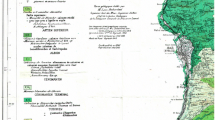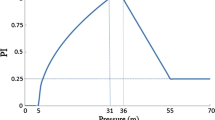Abstract
Prediction of damage to water supply lines during an earthquake is a critical part of seismic planning. This study evaluates the performance of the water supply system in Denizli, Turkey, in the event of an M6, M6.3, M6.5 and M7 earthquake associated with the Pamukkale and Karakova-Akhan Faults. The relative effects of transient ground deformations and permanent ground deformations based on maps of liquefiable soil and zones of predicted lateral ground displacements are compared. The relative effects of the different magnitude earthquakes and pipeline damage relationships on the pipeline performance following a seismic event are assessed.










Similar content being viewed by others
References
American Lifelines Alliance (ALA) (2001) Seismic fragility formulations for water systems. Part 1-guideline. http://www.americanlifelinesalliance.org
Aydan O, Kumsar H, Ulusay R (2001a) How to infer the possible mechanism and characteristics of earthquakes from the striations and ground surface traces of existing faults, seismic fault induced failures, pp 153–162
Aydan O, Kumsar H, Ulusay R (2001b) Is there a relation between the temperature changes of thermal waters in Denizli region and the earth crust at the Denizli fault zone? In: JEOTEKNIKIII, 3rd Earthquake and Geotechnical Conference on Izmir and its Surroundings, 12–14 November, Izmir, Turkey (in Turkish)
Ballantyne DB, Crouse CB (1997) Reliability and restoration of water supply systems for fire suppression and drinking following the earthquakes, National Institute of Standards and Technology, Department of Commerce, NIST GCR 97-730
Bartlett SF, Youd TL (1995) Empirical prediction of liquefaction-induced lateral spread. Geotech Eng ASCE 121:316–329
Campbell KW (1997) Empirical near-source attenuation relationships for horizontal and vertical components of peak ground acceleration, peak ground velocity, and pseudo-absolute acceleration response spectra. Seismol Res Lett 68:154–179
Campbell KW, Bozorgnia Y (2003) Updated near-source ground-motion (attenuation) relations for the horizontal and vertical components of peak ground acceleration and acceleration response spectra. Bull Seismol Soc Am 93:314–331
Celik SB (2003) Evaluation of Denizli city center lands with respect to geological and geotechnical properties and assessment of their liquefaction susceptibility, Pamukkale University, Denizli, Turkey, M.Sc. thesis (in Turkish)
Cetin KO, Youd TL, Seed RB, Bray JD, Stewart JP, Durgunoglu HT, Lettis W, Yılmaz MT (2004) Liquefaction-induced lateral spreading at Izmit Bay during the Kocaeli (İzmit)-Turkey Earthquake. J Geotech Geoenviron Eng 24(3):189–197
Environmental Systems Research Institute (ESRI) (2001) ArcGIS 9-What is ArcGIS? Redlands, Environmental Systems Research Institute Inc
Federal Emergency Management Agency (FEMA) (1999) Earthquake Loss Estimation Methodology. HAZUS 99: technical manual, prepared by the National Institute of Building Sciences
FEMA-368 (2000) NEHRP recommended provisions for seismic regulations of new buildings and other structures, Part 1 provisions
Hamada M, Yasuda S, Isoyama R, Emoto K (1986) Study on liquefaction-induced permanent ground displacements. Association for the Development of Earthquake Prediction, Japan
Iller Bankasi (Bank of Provinces) (2008) http://www.ilbank.gov.tr
Kandilli Observatory and Earthquake Research Institute (KOERI) (2000) Izmir Earthquake Disaster Master Plan for the City of Izmir, 2000. Prepared by Kandilli Observatory and Earthquake Research Institute (in Turkish). Available at http://www.koeri.boun.edu.tr
Kandilli Observatory and Earthquake Research Institute (KOERI) (2004) http://www.koeri.boun.edu.tr
Kumsar H, Çelik SB, Kaya M (2004) Geological and geotechnical urban information system for Denizli City (JEO-KBS), Conference on information technologies, Denizli, pp 25–31 (in Turkish)
Lund LV (2003) Pipeline seismic mitigation using trenchless technology. In: Proceedings of the Eight US-Japan workshop on earthquake resistant design lifeline facilities and countermeasures against liquefaction, Tokyo, Japan, Technical report MCEER-03-0003. Buffalo, NY. Multidisciplinary Center for Earthquake Engineering Research, pp 91–99
O’Rourke M (1999) Estimation of post-earthquake water system serviceability. In: Proceedings of the seventh US-Japan workshop on earthquake resistant design of lifeline facilities and countermeasures against soil liquefaction. Technical report MCEER 99-0019, pp 391–403
O’Rourke M, Deyoe E (2004) Seismic damage to segmented buried pipe. Earthquake Spectra 20:1167–1183
O’Rourke TD, Jeon SS (1999) Factors affecting the earthquake damage of water distribution systems, optimizing post-earthquake lifeline system reliability. In: Elliott WM, McDonough P (eds) Proceedings, fifth US conference on lifeline earthquake engineering, Seattle, WA, ASCE, pp 379–388
O’Rourke TD, Jeon SS (2000) Seismic zonation for lifelines and utilities, invited keynote paper on lifelines. Proceedings sixth international conference on seismic zonation, Palm Springs, CA, EERI CD ROM
O’Rourke TD, Toprak S, Sano Y (1998) Factors affecting water supply damage caused by the Northridge earthquake. In: Proceedings of the 6th US National Conference on Earthquake Engineering, Seattle, WA, USA, pp 1–12
Pamukkale University (PAU) (2001) Geological, geotechnical, and hydrogeological properties of Bagbasi (Denizli) Municipality lands, Geology Department, Engineering Faculty, Pamukkale University, Denizli, p 57 (in Turkish)
Pamukkale University (PAU) (2002) Geological, geotechnical, and hydrogeological properties of Denizli Municipality lands. Geology Department, Engineering Faculty, Pamukkale University, Denizli, p 763 (in Turkish)
Pamukkale University (PAU) (2003) Geological and geotechnical properties of Gümüşler (Denizli) Municipality lands. Geology Department, Engineering Faculty, Pamukkale University, Denizli, p 247 (in Turkish)
Saroglu F, Emre O, Kuscu I (1992) Active fault map of Turkey, printed by General Directorate of Mineral Research and Exploration of Turkey
Seed HB, Idriss IM (1971) Simplified procedure for evaluating soil liquefaction potential. J Soil Mech Found Div 97:1249–1273
Shamoto Y, Zhang J, Tokimatsu K (1998) New charts for predicting large residual post-liquefaction ground deformations. Soil Dyn Earthquake Eng 17:427–438
Sun S (1990) Geology and coal resources between Denizli and Usak, MTA Report no 9985 (in Turkish)
Taskin F (2005) Earthquake performance assessment of water supply systems using geographical information systems (GIS), Pamukkale University, Denizli, Turkey, M.Sc. thesis (in Turkish)
Toprak S (1998) Earthquake effects on buried lifeline systems. Ph.D. thesis Cornell University, Ithaca, NY
Toprak S, Holzer TL (2003) Liquefaction potential index: field assessment. J Geotech Eng 129(4):315–322
Toprak S, Taskin F (2007) Estimation of earthquake damage to buried pipelines caused by ground shaking. Nat Hazards 40:1–24
Youd TL, Idriss IM, Andrus RD, Arango I, Castro G, Christian JT, Dobry R, Liam Finn WD, Harder LF Jr, Hynes ME, Ishihara K, Koester JP, Liao SSC, Marcuson WFIII, Martin GR, Mitchell JK, Moriwaki Y, Power MS, Robertson PK, Seed RB, Stokoe KHII (2001) Liquefaction resistance of soils: summary report from the 1996 NCEER and 1998 NCEER/NSF workshops on evaluation of liquefaction resistance of soils. J Geotechn Geoenviron Eng ASCE 127:817–833
Youd TL, Hansen CM, Bartlett SF (2002) Revised multilinear regression equations for prediction of lateral spread displacement. ASCE J Geotech Geoenviron Eng 128:1007–1017
Acknowledgments
The research reported in this paper was supported by Scientific and Technological Research Council of Turkey (TUBITAK) under Project No. 106M252 and Pamukkale University Research Fund under Project No. 2003MHF006. The authors are very grateful to the Water Works staff of various municipalities for their interest and assistance in assembling the water system data and in particularly to Orhan Kaygin, Sule Vardar, Sibel Cukurluoglu and Yusuf Ornek of Denizli Municipality Water Works Department for their continuous support and discussions. Thanks are also extended to Mehmet Genc of General Directorate of Disaster Affairs, Denizli Branch, and the Geology Department of PAU, especially Prof. Halil Kumsar for providing base maps for Denizli area and valuable comments and discussions.
Author information
Authors and Affiliations
Corresponding author
Rights and permissions
About this article
Cite this article
Toprak, S., Taskin, F. & Koc, A.C. Prediction of earthquake damage to urban water distribution systems: a case study for Denizli, Turkey. Bull Eng Geol Environ 68, 499–510 (2009). https://doi.org/10.1007/s10064-009-0230-1
Received:
Accepted:
Published:
Issue Date:
DOI: https://doi.org/10.1007/s10064-009-0230-1




